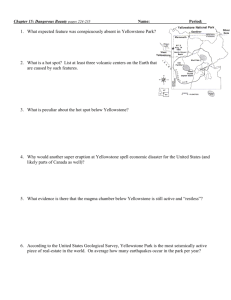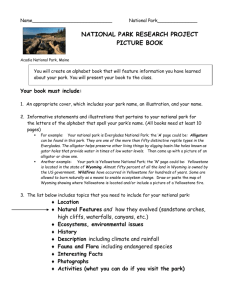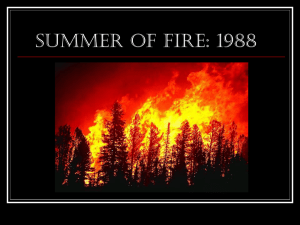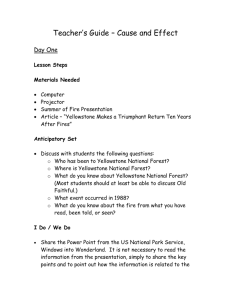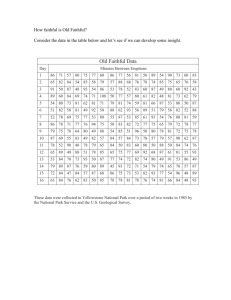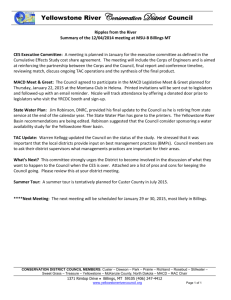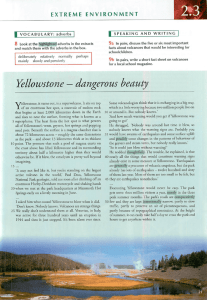Y Yellowstone by Night
advertisement
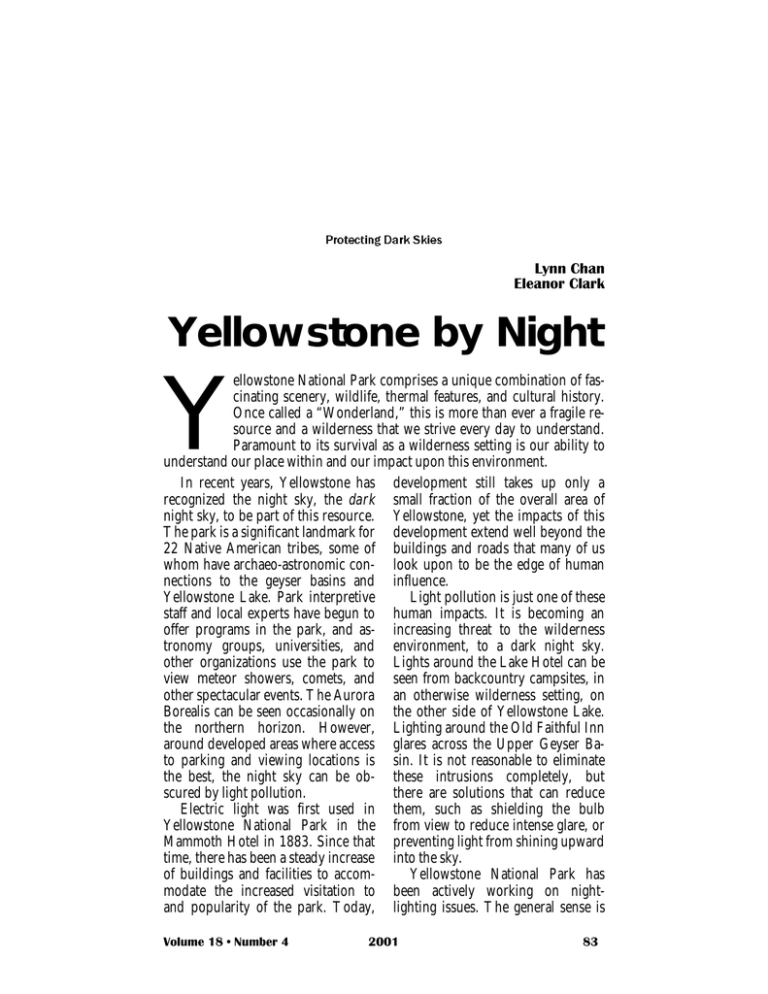
Lynn Chan Eleanor Clark Yellowstone by Night Y ellowstone National Park comprises a unique combination of fascinating scenery, wildlife, thermal features, and cultural history. Once called a “Wonderland,” this is more than ever a fragile resource and a wilderness that we strive every day to understand. Paramount to its survival as a wilderness setting is our ability to understand our place within and our impact upon this environment. In recent years, Yellowstone has development still takes up only a recognized the night sky, the dark small fraction of the overall area of night sky, to be part of this resource. Yellowstone, yet the impacts of this The park is a significant landmark for development extend well beyond the 22 Native American tribes, some of buildings and roads that many of us whom have archaeo-astronomic con- look upon to be the edge of human nections to the geyser basins and influence. Yellowstone Lake. Park interpretive Light pollution is just one of these staff and local experts have begun to human impacts. It is becoming an offer programs in the park, and as- increasing threat to the wilderness tronomy groups, universities, and environment, to a dark night sky. other organizations use the park to Lights around the Lake Hotel can be view meteor showers, comets, and seen from backcountry campsites, in other spectacular events. The Aurora an otherwise wilderness setting, on Borealis can be seen occasionally on the other side of Yellowstone Lake. the northern horizon. However, Lighting around the Old Faithful Inn around developed areas where access glares across the Upper Geyser Bato parking and viewing locations is sin. It is not reasonable to eliminate the best, the night sky can be ob- these intrusions completely, but scured by light pollution. there are solutions that can reduce Electric light was first used in them, such as shielding the bulb Yellowstone National Park in the from view to reduce intense glare, or Mammoth Hotel in 1883. Since that preventing light from shining upward time, there has been a steady increase into the sky. of buildings and facilities to accomYellowstone National Park has modate the increased visitation to been actively working on nightand popularity of the park. Today, lighting issues. The general sense is Volume 18 • Number 4 2001 83 that most lighting problems occur because those designing or installing lights do not understand the impacts of their choices. Yellowstone prides itself for its role in educating others about the environment. The park provides an opportunity each night for the 15,000 people that stay in the park to view the night sky. This is an opportunity to educate a large number, and a wide variety, of people. More and more visitors are aware of the impacts that light pollution has, not only on their own viewing of the night sky but also on their overall wilderness experience. For Yellowstone to be an innovator in this field, it is important that night sky viewing opportunities are provided and are easily accessible near campgrounds and lodging areas. Also, lighting standards for developed areas should not exceed those required for the particular purpose, and light fixtures should direct light only where it is needed, not beyond into the wilderness or up into the sky. Lowering lighting levels cannot be proposed without addressing safety concerns. Yellowstone experiences its share of crime, which is associated with both developed and remote areas. To add to these problems, there are often large and potentially dangerous wild animals roaming around the buildings and parking areas in the dark—not a comforting prospect for many people who have to venture out at night. Bison and elk particularly are often not wary of people, 84 and will act aggressively when approached, especially when they are with their young. Although this adds a significant safety concern for both visitors and employees, bright light can be a false sense of security when it creates darker and more intense shadows. Yellowstone hopes to demonstrate that lower light levels do not mean an area will be less lit, but that the available light will be used more efficiently, and that the result can be safe and effective. Addressing light levels in Yellowstone has been a daunting task. Making improvements is not as easy as replacing or removing light bulbs. A simple-looking project to reduce or redirect light output can involve rewiring and entirely new fixtures. Standards have been developed that encourage reduced light output, ground-directed light, energy efficiency, and fixtures that maintain the historic fabric of the park. The strategy has included a multi-faceted approach of innovation and correction, generating design standards to address some of the problems, and lighting design that works in historic areas. An information exhibit has been established which illustrates night-lighting principles, including actual fixtures which are lit so that staff and visitors may see examples of lights that have been developed. The first test area was the Lamar Institute, an environmentally based educational facility which reaches 2,600 students each year, some of whom The George Wright FORUM are also educators. Designing lighting for this area was a way to expose a variety of people to an alternative approach. An existing street lamp, which polluted the night sky over Lamar Valley, was removed and replaced with three 5-watt pathway bollard lights, designed and built inhouse, that direct light downward only and cannot be seen from anywhere in the valley. A porch light was designed and built in which the bulb is totally shielded on all four sides creating only downcast light. This design replaced all existing building fixtures in the area. By doing this, the wilderness experience for visitors attending the institute, and those remaining in the valley after dark, was greatly increased. Concurrently, Yellowstone is working on proposals to correct the light pollution problems at Old Faithful, Lake, and Mammoth. In all areas, the goal is to use light in the most efficient and effective way so that the wilderness setting is not polluted, but light is still available where required for safety purposes. Old Faithful is one of the main developed areas in the park, sited next to a delicate natural geyser basin. Many visitors enjoy exploring this geyser basin at night and find light pollution from the development an annoyance. The proposal at Old Faithful is to reduce the light levels through fixture redesign and replacement. This will make sure the light is directed only toward the Old Volume 18 • Number 4 Faithful Inn and parking where it is needed. The Lake area is a large complex that surrounds the edge of Yellowstone Lake, and, as mentioned above, lighting in this area affects the night sky across the lake. Here there will be parking area lights with hooded fixtures that only allow light to shine downward. In front of the Lake Hotel and at Fort Yellowstone in Mammoth, the outward glare produced by the historic lights will be reduced either by replacing or retrofitting the existing globes. Rustic bollard pathway lights will be installed along the existing path between the Lake Hotel cabins and the Lake Lodge. The bollards will face away from the lake to lessen any possible light pollution. Yellowstone continues to develop unique fixtures that can be used throughout the park and in other parks where rustic fixtures are desirable. Each of the lighting prototypes is equipped with energy-efficient technology, and is designed for use where dark skies prevail. Unfortunately, night lighting is not a priority when it comes to distributing a limited budget, so it is uncertain as to when the proposals will actually reach fruition. However, in order to be an innovator in this field, Yellowstone National Park hopes to reduce unnecessary lighting in all areas of the park so that it remains as much as possible a wilderness setting—a “Wonderland.” 2001 85 Lynn Chan, Yellowstone National Park, P.O. Box 168, Yellowstone National Park, Wyoming 82190; Lynn_Chan@nps.gov Eleanor Clark, Yellowstone National Park, P.O. Box 168, Yellowstone National Park, Wyoming 82190; Eleanor_Clark@nps.gov 86 The George Wright FORUM
